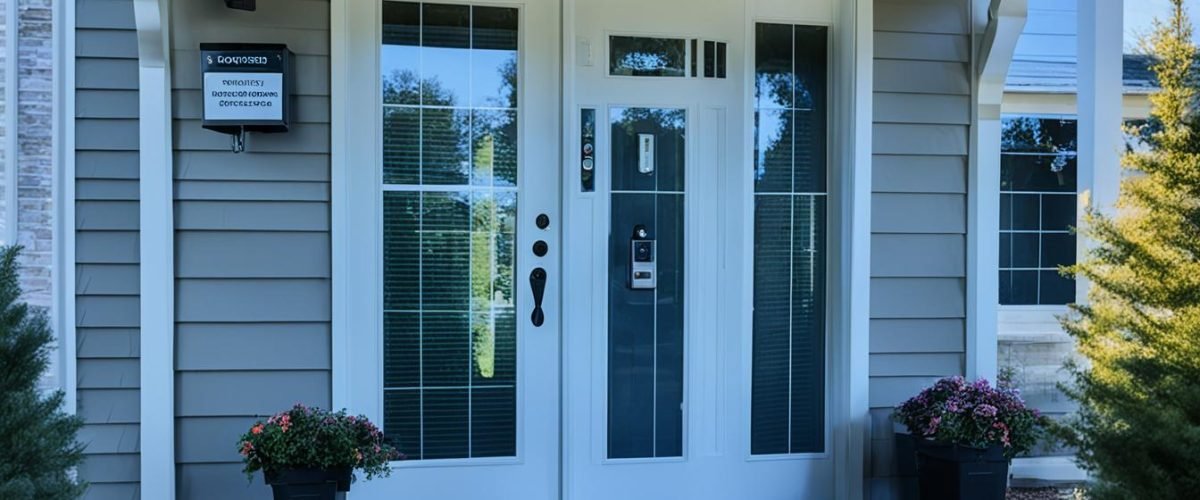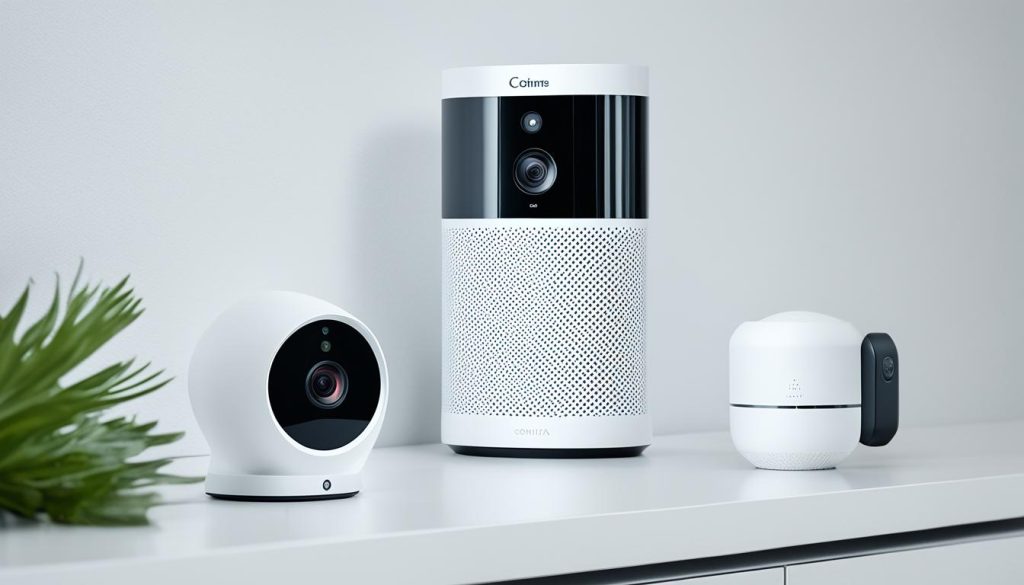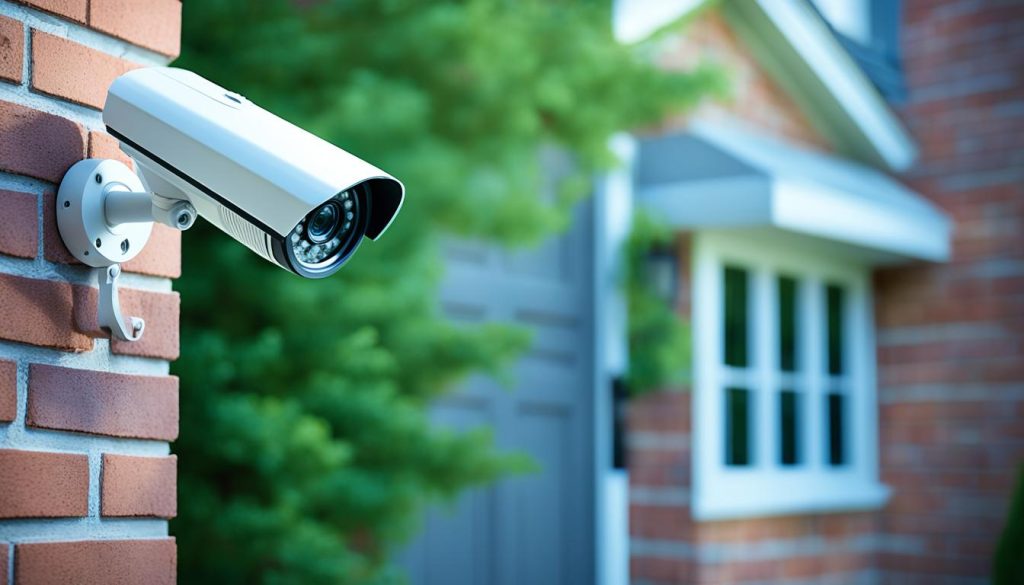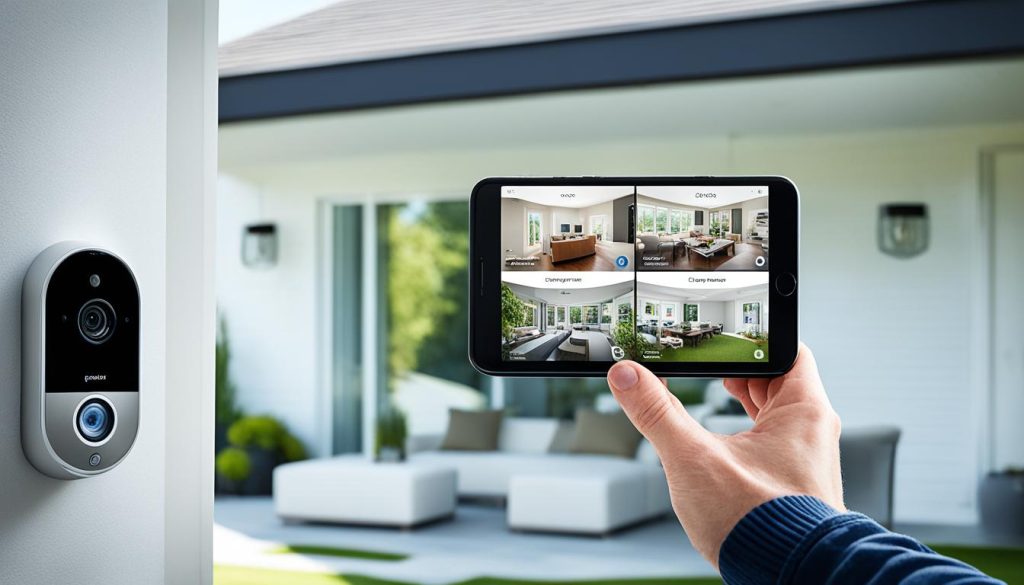Securing our living spaces is crucial for homeowners. That’s why I made this detailed guide on home security. It includes tips on how to pick the right system and find professional help. If you want to better protect your loved ones and items, or you aim to feel safer overall, this guide is for you.
Starting with home security installation is key to protect what matters most. This guide gives a clear step-by-step, from figuring out your security needs to adding smart home features. It also looks at the pros and cons of DIY security systems versus professionally installed ones, helping you choose what’s best for you.
We’ll talk about finding the best home alarm systems, getting ready for them, and setting everything up. We’ll also touch on security monitoring, making sure all your entrances are safe, and keeping up with your system. By the end, you’ll know all you need to secure your home the right way, fitting your unique situation.
Having a well-planned home security system can do a lot. It helps keep thieves away, warns you about dangers, and gives you peace of mind. Let’s get started and dive into the world of home protection.
Introduction to Home Security Installation
Keeping your home safe is very important. A good security system will stop thieves, warn you of dangers, and make you feel secure. Plus, it might save you money on your home insurance. You can also check on your home from anywhere with an internet connection.
Importance of Home Security
Protecting where you live is vital these days. A solid home security system can keep home invasions at bay, sense intruders, and alert the police when needed. By using these security tools, your home becomes a safer place to be.
Benefits of Professional vs. DIY Installation
Deciding on home security installation means choosing pro help or doing it yourself. Getting pros to do it can cost between $100 and $200. They will install the system right, giving you peace and top-notch safety.
Doing it yourself can be cheaper, especially with wireless security systems. Brands like SimpliSafe and Cove let you pick what to include, fitting your needs and budget. It takes some work, but you get a system that is both flexible and light on the wallet.
Choosing the Right Home Security System
Before you pick a home security system, think about what your house needs. Look at how big your home is and how many doors and windows it has. Also, spot any spots that might need extra safety, like a garage or basement. Think about your budget and if you want professional monitoring or you’re okay with watching it yourself.
Assessing Your Security Needs
A study by Rutgers University found something interesting. They saw that when more home alarm systems were in a neighborhood, less crime happened. This shows how important it is to choose a security system that fits your home and its unique needs.
Types of Home Security Systems
There are many kinds of home security systems, from wired to wireless. They can be simple, like alarms on doors and windows. Or they can be whole packages with security cameras and more. Choose from systems you set up yourself, ones pros install for you, or a mix of both.
Features to Consider
Think about what features are important to you in a home security system. This could be motion sensors, cameras, or smart features. Make sure your system works even if the power goes out. Also, pick one that can join forces with other smart gadgets.
In 2016, there were over 156,000 cases of vandalism in the U.S. This shows how crucial home security is. By choosing the right system, you can make your home safer. This will give you peace of mind.
Preparing for Installation
Before you set up a home security system, talk to local authorities. They can tell you about any rules or permits you need. For instance, you might have to follow rules on where to put security cameras or what kind of home security equipment you can use.
Think about where to place sensors, cameras, and other security bits for the best coverage. Look at where people could enter your home, areas they walk through a lot, and spots they might not see well. Ask the security system installer or the device’s maker about the best spots for each part.
| Planning Considerations | Key Factors |
|---|---|
| Sensor Placement | Entry points, high-traffic areas, potential blind spots |
| Camera Positioning | Optimal coverage, viewing angles, visibility |
| Control Panel Placement | Accessibility, proximity to entry points, aesthetics |
| Lighting Assessment | Exterior lighting for visibility, motion-activated lights |
| Hazard Protection | Smoke detectors, CO detectors, water leak sensors |
home security installation
Step-by-Step Installation Guide
Setting up a home security system involves a few steps. First, you place the control panel. Then, connect sensors and cameras. Finally, you program the whole system. DIY systems usually need no tools to install. However, pros might handle more complex wiring.
Always follow the manual closely to make sure you do it right. This leads to a smooth setup.
Troubleshooting Common Installation Issues
Problems can pop up even if you’re careful during installation. You might find it hard to pair sensors or connect to Wi-Fi. Sensor placement could also cause issues.
Don’t worry, though. Just look at the guide or ask for help from customer service. A bit of troubleshooting and your security system will work perfectly.
Monitoring Options and Services
Home security has two main ways to monitor: through pros or by yourself using smart home tech. The choice depends on what you want and How safe you need to be.
Professional Monitoring Services
Big companies like ADT and Vivint give you 24/7 watch over your home with their pro services. They alert you and send help when your alarm goes off. These services cost $20 to $50 a month. But, they make sure your home is always being looked after by experts.
Self-Monitoring with Smart Home Integration
Some security systems let you keep an eye on your home yourself using your phone or the web. This way, you can get alerts, see what’s happening through cameras, and control the system from anywhere. With smart home tech, you can do even more. Like lock doors or change the heat using your phone or voice commands.
Securing Entry Points and Sensors
Protecting your entry points is vital for keeping your home and family safe. Did you know, almost a third of break-ins happen when doors or windows are left unlocked? This fact highlights how key sensor placement really is.
Door and Window Sensors
Door and window sensors play a crucial role in a home security system. They sound the alarm as soon as an entry point is opened. This quick reaction can alert you and might scare off intruders. It’s important to place these sensors on all doors and windows to ensure your home protection.
Motion Detectors and Cameras
Motion detectors and security cameras add another level of safety by watching over your house. When motion detectors notice movement, they can turn on the cameras. This lets you see and record what’s happening. With security cameras inside and outside, you not only deter robbers but also have proof if a break-in occurs.
The latest FBI report mentions over 1.2 million burglaries in the U.S. in 2018. Shockingly, about a third get in through the front door and almost a quarter through the first-floor window. It shows how essential it is to secure these points with sensors and cameras for good home security installation.
When designing your security system, think about your property’s size and the number of entry points. Bigger homes will need more sensors and cameras for full home protection. This includes adding extra wireless security cameras and motion detectors.
Smart Home Integration and Automation
Technology is always moving forward. Now, we often see smart home devices working with home security systems. This makes it easy for homeowners to keep track of and control their security. They can do it all from their phone or just by speaking. It brings a new level of ease and home automation.
Integrating Security with Smart Home Devices
Companies like ADT offer home security systems that work well with other smart devices. These might include smart lights, thermostats, and voice assistants. Now, you can set your security, lock your doors, change the lights, and look at cameras all from your phone or smart speaker.
Automating Home Security Routines
Adding smart home technology to security also means your home can take care of some tasks by itself. When you leave, it can arm the security, lock doors, and set smart thermostat and lighting. This helps keep your home safe, even if you forget to do these things.
Linking smart home devices to your home security lets you enjoy more convenience and energy efficiency. It also gives peace of mind, with top-notch home protection.
Maintenance and Upgrades
Keeping your home security system in shape is key. Make a habit of checking its parts like sensors and cameras. Replace batteries in wireless devices as required to keep everything safe.
Regular System Checks and Battery Replacements
Every week, make sure your security equipment isn’t using too much power. It’s smart to dust the control panel weekly to avoid issues. Also, clean the security camera lenses carefully.
Monthly, update your home security app to stay secure and conduct tests on the control panel. Test medical alert devices and all fire alarms to ensure they work.
Upgrading to Newer Technologies
Home security technology is always getting better. You might want to upgrade to the latest tech. This can include better sensors, clearer cameras, and more smart home features. Such upgrades can make your system work better and smarter.
Don’t forget to check sensors on windows and doors twice a year. Also, look at outdoor security like cameras and lights. Ensure everything’s in order, and batteries are fresh.
Each year, see if you need more security equipment. Cut back bushes for clear lines of sight. Check warranties for chances to upgrade or get new gear. Doing regular checks and audits ensures your system stays strong.
Regularly clean your security cameras and check all wiring. This kind of upkeep will keep your home security system running for a long time. Remember, a little maintenance goes a long way.
Conclusion
Setting up home security is vital for protecting my family and our belongings. This guide explains how to pick the best system and keep it up to date. Whether we pick a DIY way or get help installing it, a good system will help us relax.
The U.S. sees more break-ins, making home security more crucial than ever. Without security, homes are more at risk. A security system can scare off burglars. Plus, it helps homes lose less money if break-ins do happen.
Choosing the right security system and installing it properly boosts our home’s safety. It’s a smart choice for our future, saving us from big losses and even cutting insurance costs. Now that I’ve learned from this piece, I’m all set to protect my family and our home effectively. Safety first!







